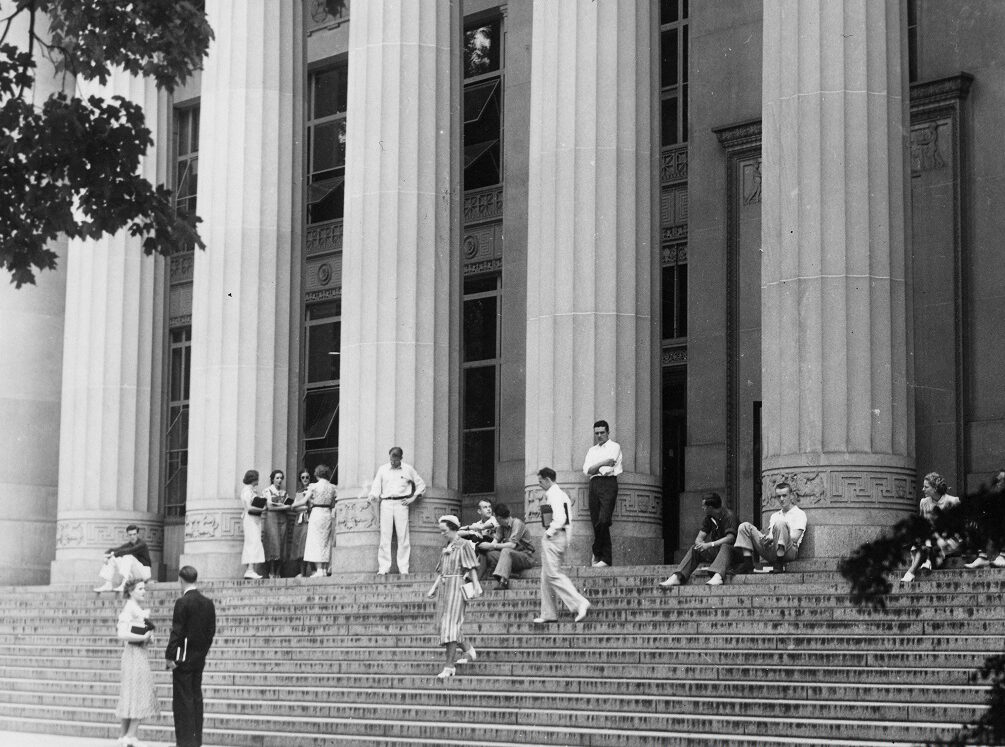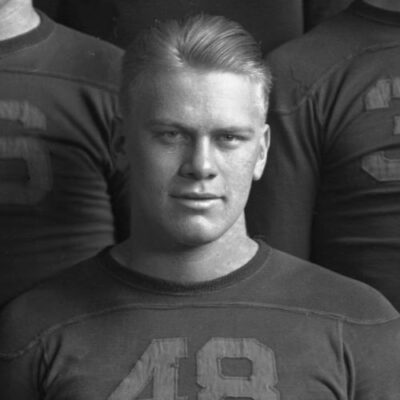Where Michigan’s
History Lives
Begin your research
Use the U-M Library Search to explore the Bentley's collections.
Hours and Location
Hours:
Monday: 10:00 AM – 4:00 PM
Tuesday: 10:00 AM – 4:00 PM
Wednesday: 10:00 AM – 4:00 PM
Thursday: 10:00 AM – 4:00 PM
Friday: 10:00 AM – 4:00 PM
Closures
1150 Beal Avenue
Ann Arbor, MI 48109-2113 U.S.A.
734-764-3482

Featured Site
Interactive Map

News
Ford on the Field

Stay Connected
Happy birthday to Gerald Ford! 🥳
Before he was President of the United States, Ford was also an exceptional U-M football player!
In his early years as a backup on the football team, Ford helped U-M win the Michigan 1932 and 1933 National Championships, all while taking part in the junior men’s honors society, sitting on U-M club boards, and studying for his classes.
The Michigan Daily featured his photo with captions like: “Ford plays stellar game,” and even noted that he could be a future “All-American.” He became known as a U-M football star in his senior year, and his teammates voted him “Most Valuable Player” in 1934!
Although Ford is better known today for his achievements on a national level, the archives show that he was also a remarkable athlete in his own right.
You can learn more about Gerald Ford’s time as a Wolverine from the Bentley’s athletics archivist in the article “Ford on the Field!”
📸: Photos of Gerald Ford from the U-M Athletic Department Records & the Rentschler`s Studio photograph collection
#GeraldFord #HappyBirthday #UMich #DidYouKnow #FootballHistory #Wolverines #GoBlue #OTD

Happy birthday to Gerald Ford! 🥳
Before he was President of the United States, Ford was also an exceptional U-M football player!
In his early years as a backup on the football team, Ford helped U-M win the Michigan 1932 and 1933 National Championships, all while taking part in the junior men’s honors society, sitting on U-M club boards, and studying for his classes.
The Michigan Daily featured his photo with captions like: “Ford plays stellar game,” and even noted that he could be a future “All-American.” He became known as a U-M football star in his senior year, and his teammates voted him “Most Valuable Player” in 1934!
Although Ford is better known today for his achievements on a national level, the archives show that he was also a remarkable athlete in his own right.
You can learn more about Gerald Ford’s time as a Wolverine from the Bentley’s athletics archivist in the article “Ford on the Field!”
📸: Photos of Gerald Ford from the U-M Athletic Department Records & the Rentschler`s Studio photograph collection
#GeraldFord #HappyBirthday #UMich #DidYouKnow #FootballHistory #Wolverines #GoBlue #OTD
...
⭐ Important update: We have some new reading room policies to share!
Please take a look at these new policies before you visit to keep your research running smoothly, and keep the historical materials here as safe as possible:
💻 Researchers are welcome to bring the following items into the reading room: pencils, erasers, camera/phone, laptop, chargers, tabletop tripods, and headphones.
📚 The number of people per table is a maximum of 2, and we accept a maximum of 14 people in the reading room at a time, to help us safely keep track of the historical materials being used.
✔️ We can be quite busy, so we now highly encourage scheduling an appointment. This will help you make sure you have a spot in the reading room when you visit!
📆 Meeting rooms are reserved for staff and class use, and will require a request in advance.
🚘 As of July 14, the new university parking system requires visitors in our parking lot to provide the Bentley with their license plate number, the make of their car (ex. Ford, Toyota, etc.), and their name, so be sure to check in at our front desk when you arrive.
You can see our full list of in-person research policies on the Bentley`s website, and if you have any questions, please feel free to reach out to us at: bentley.ref@umich.edu
We appreciate everyone who visits the archives, and we look forward to seeing you in the reading room!
#ImportantUpdate #NewPolicies #ReadingRoom #BentleyHistoricalLibrary #Research #KnowBeforeYouGo

⭐ Important update: We have some new reading room policies to share!
Please take a look at these new policies before you visit to keep your research running smoothly, and keep the historical materials here as safe as possible:
💻 Researchers are welcome to bring the following items into the reading room: pencils, erasers, camera/phone, laptop, chargers, tabletop tripods, and headphones.
📚 The number of people per table is a maximum of 2, and we accept a maximum of 14 people in the reading room at a time, to help us safely keep track of the historical materials being used.
✔️ We can be quite busy, so we now highly encourage scheduling an appointment. This will help you make sure you have a spot in the reading room when you visit!
📆 Meeting rooms are reserved for staff and class use, and will require a request in advance.
🚘 As of July 14, the new university parking system requires visitors in our parking lot to provide the Bentley with their license plate number, the make of their car (ex. Ford, Toyota, etc.), and their name, so be sure to check in at our front desk when you arrive.
You can see our full list of in-person research policies on the Bentley`s website, and if you have any questions, please feel free to reach out to us at: bentley.ref@umich.edu
We appreciate everyone who visits the archives, and we look forward to seeing you in the reading room!
#ImportantUpdate #NewPolicies #ReadingRoom #BentleyHistoricalLibrary #Research #KnowBeforeYouGo
...
We’re sharing historical cats who think they’re kittens, in honor of National Kitten Day!
Which one is your favorite?
📸: Cats from the Maude Sink scrapbook, Frances Green scrapbook, and Emile Lowe scrapbook, plus a bonus kitten from the Thomas Shaw photo collection
#NationalKittenDay #Archives #VintageCats #HistoricalPhotos #KittensOfInstagram

We’re sharing historical cats who think they’re kittens, in honor of National Kitten Day!
Which one is your favorite?
📸: Cats from the Maude Sink scrapbook, Frances Green scrapbook, and Emile Lowe scrapbook, plus a bonus kitten from the Thomas Shaw photo collection
#NationalKittenDay #Archives #VintageCats #HistoricalPhotos #KittensOfInstagram
...
These baby wild turkeys and their parents recently decided to stop by our library courtyard! 🦃
They clearly enjoyed the Historical Circle sculpture by Richard Hunt; as you can see, they climbed right to the top of it. While we don’t encourage climbing the sculptures, we do appreciate their interest in history!
If you, too, want to visit the Bentley to explore Michigan’s past (and possibly spot some wild turkeys) you’re welcome to visit our reading room during our open hours. The Bentley is open to the public in both the summer and the school year. 📖❤️
Thank you to Bentley Research Associate Andrew Rutledge for these wild turkey photos!
#WildTurkeys #UMich #Archives #HistoricalLibrary #BabyWildTurkeys #Poults #Birds #SoCute #SupportYourLocalLibrary

These baby wild turkeys and their parents recently decided to stop by our library courtyard! 🦃
They clearly enjoyed the Historical Circle sculpture by Richard Hunt; as you can see, they climbed right to the top of it. While we don’t encourage climbing the sculptures, we do appreciate their interest in history!
If you, too, want to visit the Bentley to explore Michigan’s past (and possibly spot some wild turkeys) you’re welcome to visit our reading room during our open hours. The Bentley is open to the public in both the summer and the school year. 📖❤️
Thank you to Bentley Research Associate Andrew Rutledge for these wild turkey photos!
#WildTurkeys #UMich #Archives #HistoricalLibrary #BabyWildTurkeys #Poults #Birds #SoCute #SupportYourLocalLibrary
...
Hours and Location
Hours:
Monday: 10:00 AM – 4:00 PM
Tuesday: 10:00 AM – 4:00 PM
Wednesday: 10:00 AM – 4:00 PM
Thursday: 10:00 AM – 4:00 PM
Friday: 10:00 AM – 4:00 PM
Closures
1150 Beal Avenue
Ann Arbor, MI 48109-2113 U.S.A.
734-764-3482
- Copyright © 2025 The Regents of the University of Michigan
- Land Acknowledgment Statement

